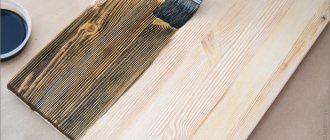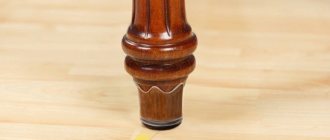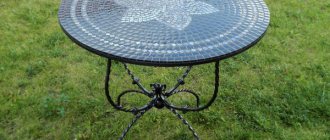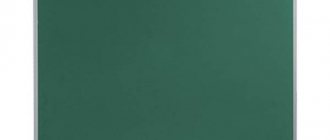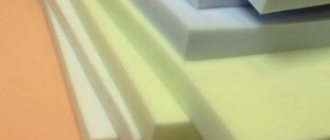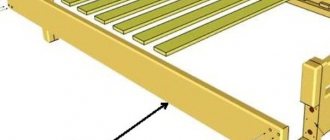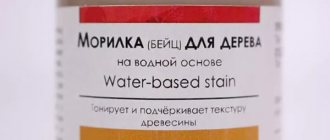Why and how do they fight wood? Modern stains (stains).
The pinnacle of nature's creations, in a large list of building and structural materials, is, of course, wood.
Its unique physical and mechanical properties have been known for a long time, and it is thanks to them that wood has been used for various structures and the manufacture of products for thousands of years. If we are talking about products that surround us in everyday life (doors, floors, stairs, furniture, etc.), then the aesthetic characteristics of wood come to the fore: a variety of shades, unique texture, fancy patterns, natural warmth, pleasant to the touch . But no matter how hard nature tries, man still strives to complete her creation - there is no limit to perfection. This concerns changing the shades of wood and emphasizing the uniqueness of its texture, which allows you to achieve excellent decorative effects. Wood stain is designed to achieve this result.
Beitz is a special product in the form of a liquid that does not form a surface film, but penetrates deeply, coloring the wood itself, thanks to which, unlike paints, it makes the wood texture visible. (Otherwise this product can be called “stain”).
Wood stains are a modern, high-quality product based on a unique combination of low-odor solvents and natural oils. Simplicity of application is ensured by the “Easy to use” formula, due to which the product gradually and evenly penetrates the wood. This allows you to easily and quickly obtain the desired decorative effect and emphasize the noble beauty of wood. It should be noted that the stain contains UV absorbers that prevent the color from “fading” under the influence of direct sunlight.
What, how and in what sequence should I do to perform high-quality cladding of wood? We provide answers to these questions in step-by-step instructions.
How to work with stain?
Absolutely any stain reveals wood imperfections. If you want to get a high-quality result and want the wood to look efficient and presentable, then pay special attention to its preparation for coating.
– Sand the surface.
– Remove dust and debris.
– Additionally treat the product with white alcohol. It will help eliminate fat stains, even those that are not visible to the naked eye.
– If there is already paint on the wooden base, it must be removed. Next, the surface is degreased and dust is removed.
After this, you can begin work on applying stain.
– Dip the brush, rag or other material you are working with into the stain.
– Apply the solution. If you are working on a vertical surface, apply the product from bottom to top.
– Leave the first layer for the time indicated in the instructions. The degree of evaporation depends on the wood and the type of stain.
– After the first coat has dried, apply the second. And so on until you get the shade you planned.
We offer you to purchase high-quality stain from a manufacturer in Moscow and Novosibirsk in wholesale quantities. If you need products at a low price, you want to purchase this material one-time or on an ongoing basis, then contact our specialists for advice, conclusion of an agreement, or purchase. We will help you make a choice, guide you in price and supply any wholesale batch of stain for your business.
How to apply stain to wood
Step one: surface preparation
Proper preparation of the wood surface is the key to high-quality facing and a wonderful aesthetic appearance with uniform color. It's like the foundation for a house. Therefore, before starting to apply stain, we sand the surface of the wood along the grain with sandpaper with a grain size of 120-320. When matting surfaces that have previously been treated with other paints and varnishes, they must be completely removed. Removal of the old coating can be combined with sanding.
We clean the sanded surface from dust (you can use a vacuum cleaner) and other contaminants. We wash greasy and tarred areas with purified gasoline and let them dry.
High-quality surface preparation facilitates the application of stain, helps to obtain uniform coloring and an expressive pattern of wood texture. Therefore, we emphasize once again: this stage should in no case be neglected!
Step two: preparing stains (stains)
Before applying the paint, mix it thoroughly until a uniform consistency and color is obtained. The product does not need to be diluted, because it is ready for use.
There are many ready-to-use colors in the assortment, so you can always easily choose a shade to your liking.
Step three: applying stain
To apply the stain, use a sponge, tampon or soft cloth, with which you carefully and evenly rub the product into the wood. We do this at an ambient temperature of +5 to + 30 ° C. Under such conditions, the product gradually and evenly penetrates deep into the wood without lifting its fibers. This is very important, because in order to apply the next layer you do not need to perform interlayer sanding of the surface. Remove excess product that the wood has not absorbed with a rag.
The innovative formula ensures long open time. Thanks to this, any adjustments and corrections can be made even 30 minutes after application.
To achieve the desired color intensity, apply one or more layers of stain at intervals of 24 hours.
Step Four: Surface Protection
The resulting surface with a uniform color and pronounced wood texture is protected with a transparent varnish. We select varnish in accordance with the operating conditions of the product.
If all recommendations are strictly followed, the noble appearance of the product for many years is guaranteed.
Features of using wood stains
Wood stain is a perfect, innovative product that does not harden as a layer on the wood, but penetrates deep into its texture. The level of protection of the material from rotting depends on the composition of the product you purchase. It can have a maximum degree of protection (for use in wet rooms or outdoors) or a minimum (for use of wooden products indoors). Please note on what basis the stain is created. If it contains wax, acrylic or oil, then this material is guaranteed to protect the base material from rotting.
An important advantage of wood stains is their cost. You can choose a product that best suits your price. Thanks to a wide range of prices, every buyer can choose a jacket that is comfortable for his budget.
If you pay attention to water-based wood stains, then be careful. This composition requires additional work. For example, water is quickly washed out of wood and does not protect it at all. Therefore, this stain needs an additional protective layer. Apply several coats of varnish to the wood after you are finished with the stain. Then you can be sure that your foundation is reliably protected.
Also note that when using a water-based wood stain, you may be lifting the pile. This nuance is eliminated only during subsequent grinding.
Characteristics of wood stains
There are four types of wood stains. This classification is based on the element on which the product is created:
In addition, stain is characterized by its ability to penetrate into the structure of its base.
Help what fighters are.
It’s just that furniture makers use this slang word, but I use more general construction paints. And today one person said that he did a cool thing with our decoration and stain. We want to try it ourselves. I suspect this is most likely a colored alkyd varnish (at least not a water-soluble one).
Beitz is a German word. I don’t know how to translate it correctly. In practice it means walnut stain with water solution. According to the information I have, this is a specially rotted peat, the deposits of which were found only in Germany. By now it has either been depleted or production has stopped. The name remains and is used for a synthetic product, which can be either a powder, like a real stain, or a ready-made solution. Perhaps now it is applied not only to water-based stains, but I have not come across such names.
In fact, stain is not exactly a stain, but a dye. The composition includes a base (water, nitro varnish, wax composition), dyes, pigments and various improving additives to impart the necessary technological and decorative properties. For example, negative texture, color uniformity, aging effects. It’s difficult to do it yourself: you need to know the secrets. You have to buy ready-made, the basis for success, IMHO, is thorough mixing, and trial test applications won’t hurt.
2vestochka water, nitro varnish, wax composition - it's all in one bottle. I can't believe it.
Grandfathers-carpenters worked with the soldiers. But they didn’t reveal the recipes to us young people, so I still don’t know. And the fighters, as I understand it, were different. According to need. Some were on water, others were on a nitro base, others were on natural wax, the most common were on alcohol. I remember they were diluting shellac, rosin, dyes in bags for wool, and some other rubbish. .
Look at the forum question dated 06/23/06. “Decorative painting of a light bedside table under WENGE”, the concept of stain and stains was already discussed there. I’ll add that stains also belong to this class: stain is, indeed, a German term, stain is Russian, and stain is Anglo-American.
2Demid Thank you, I found it and read it, but there is a significant BUT: the reasoning there boiled down to the fact that stain is a stain, and nothing more. And this is not a finishing coating. A furniture maker came to us, said that this was a FINAL coating, and boasted that he was using 6th generation stain. So my opinion at the moment is that stain is still more of a colored varnish than a stain. But just an opinion. Now I’ll try to ask a specialist on this topic to answer here.
I have been selling beys since 1996. Stain means any material that gives color to wood while preserving its structure. They are different. Basically, they are divided into three large groups: solvent-based, water-based, and alcohol-based stains, although many people classify the latter as solvent-based stains, but usually this group is an intermediate link. That is, for example, there are bean concentrates that can be diluted with water or alcohol, while other bean concentrates can be diluted with a solvent or alcohol. There is definitely a priority to using stains on different bases for different types of wood. For example, water stains are best used for beech, since this results in a very beautiful and uniform surface. For resinous rocks, alcohol-containing stains are generally suitable. For oak, the best effect is obtained from stains containing solvents. Recently, with the development of the chemical industry, the lines between paints on different bases have been erased. I already know alkyd-water-based stains, that is, they are used as previously thought to be mutually exclusive bases. In addition, dyes are also divided by the type of dye used. It can be organic or synthetic. As a rule, now they mainly sell synthetic-based dyes, and Italian manufacturers especially suffer from this. They use the same pigments that are used to produce paints. Organic fighters are more expensive. To obtain different effects, various resins can be added to it, for example, to even out the color, nitro resins can be added to the stain, in this case we get nitrobes. As a rule, the dry residue of the stains does not exceed 10%, so they must be covered with a protective layer on top. When the dry residue exceeds 20%, these compositions are already classified as varnishes or other glazes. The word stain itself is German; in a chemical dictionary it is translated as dye or stain. As for stains that are not covered with a protective layer, this probably means colored oils. This is not stain, but a separate group of paints and varnishes.
Application of waterborne stains
Water-based stains allow you to obtain very attractive, bright colors with good uniformity of application and a variety of shades.
However, water-based stains raise the pile and can cause swelling of the fibers and other textural elements on the surface of the wood. They require longer drying time before applying subsequent layers.
Beitz water from Sopur
Water stain is an environmentally friendly product based on water, dyes, pigments and enhancing additives.
Beitz is characterized by very good flow and uniformity of color. The composition of the product's ingredients gives the effect of a peculiar silkiness. Has good light fastness (in the interior). Gives the layers of wood an even character.
| Rice. 5. Sopur water stain |
Antique water stain from Sopur
Antique water stain (stain) is a product based on aqueous acrylic dispersion, dyes and micronized pigments.
Beitz is characterized by good flow and strong emphasis on the wood grain, giving the painted surface a rustic effect.
Stain creates a uniform coloring effect in transverse and longitudinal cuts of wood. Beitz has good light fastness (in the interior). Contains no solvents and does not emit formaldehyde.
| Rice. 6. Antique water stain from Sopur |
What are the differences between using organic solvent-based stains and water-based stains?
Resins and oils found near the surface of the wood can cause spotting when tinted with stains.
Organic solvents have the ability to dissolve resins and oils and take their place. As a result, such areas absorb more stain. In turn, stains on water are repelled by resinous areas of the surface.
Alternation of more and less dark color spots often occurs when tinting deeply absorbing wood species that have a trunk shape that is far from cylindrical. This is especially clear for birch.
What are the differences between the use of water-borne stains obtained by dissolving dyes and stains with dispersed dye?
Stains, which are solutions of dyes in water, are not recommended to be coated on top with water-based primers, since the water contained in the soil can again dissolve the soluble dyes, introduce them randomly into the soil, and as a result the surface can become spotty.
Water-based stains of the second type, with dispersed pigments, are practically free from this limitation.
Feedback from site visitors:
Mostly, judging by the description in the article, I worked with impregnations. We painted stairs and wooden furniture with a brush in two approaches using tinted Pinotex impregnation. Then, a day or two after drying, the surface was covered from a paint sprayer with nitro varnish produced by Yaroslavl paints or Dufa oil varnish, the one with a hedgehog, in the case of an expensive version.
Painting was carried out in poor conditions in a room fenced off from the main workshop by wooden partitions with polyethylene, no painting chambers, only a pipe and a fan, and the protective equipment was a gas mask, this was in the early 2000s.
Later, when we began to switch to mass production of wooden furniture, we first became acquainted with Polish-made nitro stain. At first they bought it from resellers, and as volumes grew, they transported it directly from Poland, the director got into the car and hit the road.
Beitz dried quickly and was not as toxic as impregnations. But, as always, there were nuances - the stain was applied with a paint sprayer and the result depended on the skills of the painter, how he set up the torch, at what distance he held the spray gun from the surface being painted and other parameters. It turned out that if there were two painters, the output would be different shades, and in mass-produced furniture this is critical.
In addition to the shade, there was also such a defect as spotting when applying stain, which also depended on the professionalism of the painter. With skillful application, the stain lay down smoothly, without drips, and, moreover, a skillful application technique made it possible, by varying the number of layers applied and the amount of stain applied in one approach, to even out different shades of wood. But over time, as I gained experience, everything settled down in this regard.
By the way, there were attempts to apply stain in a different sequence - first a transparent primer, and then stain on top. It turned out beautifully - the color is different, more saturated and bright compared to the option when the stain is applied first. But here, any mistake by the painter required regrinding the parts.
What is stain used for?
As is already clear from the first paragraphs, stain has several main functions:
- Antiseptic - as protection against pests and mold. Due to the fact that the stain penetrates deeply and does not remain on the surface, like paint, the material does not rot longer.
- Water-repellent - especially important if the tree is in unfavorable conditions with high humidity (for example, in a bathhouse) or outdoors.
- Painting wooden surfaces in natural colors. Sometimes wood is refined with the help of stain, giving ordinary species the color of more expensive wood.
- Gives a distinct texture to wood.
- Some stains contain fire retardant (fire retardant) components.
Stain can also be used to restore outdated wood products, which is why it is often used in restoration.
What to consider when choosing wood stain
Knowing the features of various modifications of these solutions, it is not difficult to understand. Therefore, the author only summarizes all of the above:
- Specifics of application - inside or outside the building; temperature, humidity; weather.
- Structure (species) of wood. The lower the density, the more deeply the stain penetrates. For example, the use of water-based compounds will significantly increase their consumption per m2. How justified, expedient, etc. is this? There is one more nuance. After treatment, the color of the wood will be slightly “lighter” than expected. This is due to the fact that a significant part of the stain will be absorbed, and along with the liquid, the dye.
- Condition of the wood. Does the lumber have defects that need to be leveled out, or, on the contrary, do you need to emphasize all its advantages? This should also be taken into account when choosing a stain based on shade.
- Personal experience and opportunities. The first one is clear - not everyone will be able to properly apply the required layer of stain, which dries (is absorbed) quickly. It depends on practical skills. It's more difficult with possibilities. As a rule, most “home craftsmen” work with a brush. To apply wax stains, it is recommended to use tampons. Also – nothing special. But does everyone have not only a spray gun, but also a “source” of compressed air? You should think carefully before choosing alcohol stains.
- General interior. This mainly concerns interior finishing work. As a rule, no one is involved in the surface design of wooden parts of a building or individual structural elements, otherwise one of the advantages of lumber is lost - its naturalness. Therefore, it is necessary to focus on the shade that the stain will give to the wood, and how much it will emphasize its structure (or change).
How to choose a stain for woodworking
To choose the right stain for your needs, you need to take into account several conditions.
- So, stains, first of all, are for interior and exterior work. Thanks to a special pigment, external stains have increased moisture protection and do not fade from exposure to direct sunlight.
- An important point is the method of applying the stain: some compositions are intended for tinting wood with a brush, while others are intended for tinting wood with a spray gun.
- If you need to stain wooden surfaces, for example, in a children's room, or those that will be in contact with food, then it is important to choose a stain with non-volatile ingredients in the composition. Furniture and wooden surfaces should not only be beautiful, but also safe.
There are five types of stain composition, and each of them has its own area of application. Let's talk in more detail about each of the compositions.
You may find it useful
Water based stain.
This is the safest type of stain, ideal for interior work, its price is the most affordable, but it has a number of disadvantages:
- Water penetrates deep into the layers of wood, causing it to swell. Therefore, after staining, a long drying time is needed;
- after water stain, additional treatment with varnish or oil is needed;
- Resin wood cannot be treated because the pigment is distributed unevenly, causing spots and bald spots to appear.
Oil based stain.
Consists of pigment and linseed oil or drying oil. The coloring result is brighter and more uniform, the oil adds a pleasant natural smell to the wood. The surface after staining is protected from moisture and ultraviolet radiation.
When stored for a long time, the stain in oil thickens, and to dilute it, use the solvent “White spirit”.
You may find it useful
Alcohol based stain.
Penetrates deeply and dries quickly, thanks to this it has good protective properties and is used for external work. It is rarely used indoors due to its pungent odor. Alcohol stains are applied with a spray gun, since when applied with a brush, stains may form due to rapid drying.
Stain based on natural wax and acrylic.
These are relatively expensive compounds often used in restoration. Wax-based stain has high water-repellent properties, it has no pungent odor and a huge selection of colors. Disadvantages include heterogeneity of coloring with multi-layer coating.
Solvent-based stain (nitro stain).
The results of staining are similar to alcohol staining. Cannot be applied without using personal protective equipment. Stains are sold either in ready-made liquid form or in powder form, which you must perfect yourself by diluting according to the instructions.
When choosing a stain color, you need to take into account that each surface of different types of wood has individual characteristics, and the stain pigment can appear differently everywhere. Therefore, the color that the manufacturer promises is more of a recommendation. Ideally, before the main work, you need to make paint samples.
You may find it useful
Which stain to choose?
Choosing a stain
When selecting a stain, focus on the following parameters:
- Composition type . If your budget is limited, water stain is suitable for tinting. But it is not recommended to use it in open spaces - use alcohol stain instead. If everything is fine with the budget, then it is recommended to use an oil or acrylic composition.
- Wood color . Typically, people use stain to age wood, making it look more aristocratic. For these purposes you need to buy a dark Benz. If you are working with dark wood, you can use a lightening stain.
- By method of sale . Stain is sold in powder or liquid form. The powder has a longer shelf life, but it must be prepared before use (fill with water or solvent depending on the type of stain). Liquid mixtures are ready for use, but they do not last long.
Wood stain video
How to use stain correctly
As in any business, half the success lies in proper preparation - in this case it is important to properly prepare the surface of the wood being processed:
- If there is already some kind of coating, it is dismantled and the entire surface is sanded with sandpaper.
- The surface is degreased with solvents.
- If the tree is coniferous, it is deresined by applying a special composition.
- If a water-based stain is used, the raised lint on the wood is removed.
- A test paint is carried out either on a similar piece of wood, or directly on the product, where it will be least noticeable.
The next step is choosing the tools to use. Experts recommend choosing a spray gun and spray gun for alcohol and nitro stains. Oil, wax and acrylic stains are best applied with lint-free swabs and wide brushes with natural bristles, and water stains are best applied with swabs, synthetic brushes or rollers.
The dyeing process itself comes in two types:
- coating followed by removal of excess (suitable for water stain);
- without removing excess (oil, acrylic and wax sealants are quickly absorbed and no excess remains).
To enhance absorption, the stain is heated. Using the application method using a roller brush, the tampon should not be soaked too much in the composition of the instrument. You only need to lightly moisten it to avoid smudges and uneven application. The wood should be coated with stain along the grain, trying not to be interrupted in order to achieve the same color.
Next you need to leave the surface to dry. Different stains have different drying times:
- water – 12-20 hours;
- oil – 2-6 hours;
- alcohol and nitromortar – up to 30 minutes;
- wax and acrylic – 4-5 hours.
After the stain has completely dried, another 2-3 layers are applied until the desired shade of wood is obtained.
Staining is an affordable and effective way to preserve wood products, while allowing you to emphasize the texture of the material and give it the desired natural shade. If you have unfinished wood surfaces in your home or property, try protecting them with a stain to ensure they last for years to come.
Work technology
Let's now find out how to work with stain in practice.
How to apply stain
Beitz is recommended to be applied to clean wood. If there is a layer of paint or varnish on the wood, you need to get rid of it in the following ways:
- To remove old varnish, special chemical removers are used. Buy this composition at any hardware store, prepare and apply it according to the instructions.
- To get rid of a thick layer of old paint, you need to coat it with solvent and then cover the surface with cellophane. The next day you need to scrape off the soaked paint with a spatula, sandpaper or sander.
- In the case of a thin layer of paint or varnish, you can use acetone solvent. Saturate a rag with it, wet the surface, wait 5-10 minutes, and then remove the varnish or paint with a spatula.
Finishing work rules
Applying stain in general is very similar to conventional staining:
- If you apply stain to bare wood. Using a brush or spray gun, carefully apply the composition over the entire surface. When it dries (shelf life depends on the type of stain), reapply another coat of stain in a thicker layer.
- If you apply stain to stain . You can also use a brush or spray gun to re-tint. However, you only need to apply one additional coat (note, however, that it should be thick enough to cover the old stain).
Dealing with defects
If applied incorrectly, streaks and stains may appear. Let's find out how to deal with them:
- Streaks . If you notice a leak immediately after application, apply a layer of varnish over the stain. As a result, the varnish will dissolve the stain, and the mixture will turn into a thick liquid - remove it with a rag. If a leak is discovered after drying, then do exactly the same work, only use white spirit instead of varnish.
- Spots . You need to work on the same principle as with streaks - remove the stain using varnish or white spirit, apply a new layer of stain. If the stain layer is thick enough, the stain can also be removed using a plane with a well-sharpened blade.
How to remove stain
How to wash off stain
Water stain can usually be washed off with tap water. But the rest of the compositions are quite stable, so they can only be washed off with a good solvent or white spirit. Grouting must be done carefully, since the solvent will wash away both the stain and the “native” dyes. If the composition gets on clothing, it is better to throw it away, since washing will be ineffective.
Wood stain: types, colors, how to apply.
Various paint and varnish materials can be used to process wood, but most of them serve to create a top decorative and protective coating, which also covers the design. If wood stain is used, the result is completely different.
This material, which is called “stain” in a professional environment, allows you to give the desired color or shade, without hiding the beauty of the wood, but, on the contrary, more clearly showing its pattern and revealing all its beauty. Skillful use of stain can enhance any piece of furniture or other wood product.
Choosing a wood stain - the main types, what it is needed for and how to use it
Today there is such a variety of wood impregnating agents on sale that even a specialized specialist cannot clearly answer the question of what their fundamental difference is. If you read the instructions for the preparations, the conclusion suggests itself that most of them protect wood literally “from everything.” So why do you need wood stain? Is it only for toning it, as is commonly believed?
- Wood tinting while maintaining its texture.
- Reliable protection of the material when other means are ineffective or their use is not economically feasible. Reasoning - stains are characterized by a greater depth of penetration, while being cheaper than paints, varnishes and a number of other preparations used for wood processing (at least 2.5 times).
- Imitation of another, more expensive breed.
- Wood bleaching. This is often done either during its restoration, or in preparation for painting (applying colored varnish).
- Protecting the material from rotting (antiseptic function) and destruction by wood-boring insects.
- Combining shades, creating the effect of surface finishing with different woods.
- Some stains strengthen its structure.
- Giving (partial) moisture-repellent properties to lumber.
- Any stain, regardless of composition, definitely increases the shelf life of wood.
But is it really that simple? Is it enough to buy any of the commercially available stains, and all problems with reliable wood processing are solved? A comprehensive answer can be obtained by familiarizing yourself with all the types of liquids in this group. By the way, stains are often called differently - stains - and they are used not only to protect and prepare for further use of natural wood, but also building materials based on it (plywood, MDF, fiberboard, OSB, chipboard).
Types of stains
Stain is a solution of a special pigment that has coloring, protective, antiseptic and other properties, and the classification is carried out according to the type of base. Thus, all fighters can be divided into:
- aquatic;
- alcohol,
- oil;
- acrylic;
- waxy.
Rustic stains are also a separate type, the base of which can be any. Their main feature, according to which they are included in a separate group, is the receipt of a method of wood processing in which it is possible to obtain a play of several colors in the treated area.
Usually, for testing, a board of the same type as the surface being treated is used, but this option is not always possible, and therefore the back surfaces of the products should be selected for this.
Magazine "Furniture Factory" No. 4, 2010, pp. 58-61: Wood tinting
Toning is often the most important and complex technological operation in the transparent finishing of solid wood or veneer. The tinting composition is applied directly to the wood and, interacting with it, gives a variety of decorative effects. The aesthetic features of the products largely depend on this operation. Currently, there is a wide variety of tinting compositions that allow you to achieve one or another depth of color, transparency, obtain different color surface textures, and an original “speckle”. In the highly competitive furniture market of Russia, you can significantly increase the demand for products by guessing which “speckle” is in fashion.
Wood tinting has a long history; many appropriate methods and materials have been created, but today in the industrial production of furniture and interior doors, tinting of three main groups is widely used: stains, stains, glazes .
Stains
Stain is a material that makes wood look like stained wood, that is, it gives a tint to the wood itself, impregnating its fibers. After tinting with stain, the color of the wood becomes saturated and the texture becomes pronounced. The stain does not create a continuous varnish film on the surface of the wood. This type of tinting is traditional for the Southern European school of wood finishing, in particular Italian. Two types of stains are widely used: texture-emphasizing and leveling (sometimes the term “harmonizing” is used).
Highlighting stains are a classic type of stain that provide deep penetration. Such stains are solutions of dyes and do not contain binders or resins intended to fix dyes on wood. Dissolved dyes penetrate the wood together with the carrier solvents and are retained in microcapillaries, microcavities about hundredths of a micron in size. Thus, highlighting stains provide volumetric rather than superficial coloring of wood, without veiling the texture, without a grayish tint, which sometimes occurs when binder resins are present in the composition. Of course, areas of the wood grain that are more absorbent, the early layers of growth rings absorb more stain and acquire a richer color. The tone of such areas becomes darker. Emphasizing stains reveal not only the structure of annual rings and flakes, but also visually highlight individual fibers on the surface of the wood.
When emphasized moderately under a silky clear varnish, wood with an accentuating stain can shine with an inner light. This tinting looks most natural on species that do not have a pronounced color texture, for example, on birch or on poorly absorbent species (oak, ash). For example, in Fig. Figure 1 shows a finish using TMM006 highlight stain from Renner Italia on birch, oak and beech. The effect of emphasizing texture depends largely on the thinner used to dilute the stain concentrate to the desired color intensity, and on the technique of applying the stain. Diluting the stain with a slow thinner, applying it with pneumatic spray with a too “wet” torch, and even on wood with high absorbency, can lead to excessive emphasis. As a rule, the so-called negative effect is considered undesirable, in which the initially lighter areas of the early wood of the growth rings become darker.
Water-based stains
This type of stain is the most common and popular, represented by a wide range of colors, but exclusively natural colors inherent in wood.
Therefore, water-based wood stain is used only as a means to impart a certain shade, which may not coincide with the original one.
Among the advantages of this type are:
- environmental friendliness and safety;
- large selection of tinting shades;
- ability to penetrate deeply into the wood structure;
- ease of changing or adjusting the shade during work and if necessary, since the previous layer can be washed off and a new one applied.
One of the relative disadvantages is the long drying period of products treated with the composition. And, in addition, you will have to think about what to do with the boards after covering them with stain, since in this case there is an urgent need to apply an additional layer of protective coating, most often colorless varnish.
But when choosing this type for processing wood products, you should also take into account the fact that deep penetration of the solution can also have negative consequences, including:
- deterioration of moisture resistance;
- lifting of fibers, which requires additional work to grind the surface;
- deformation of wood products from moisture, for example, their twisting, cracking, etc.
Depending on the desired result, water-based stains can be applied in one or more layers, and they can be purchased either in ready-to-use form or in powder form.
Modifications of stains
They are classified depending on what they are made from. They go on sale in the form of ready-made liquids, gels or powders, but the properties of stains depend only on the components and their proportions.
Water fighters
- Such stains come in a wide variety of shades, so you can choose the composition for almost any type of wood and make it the required tint in relation to the interior of a particular room.
- "Environmental Safety". For those who are concerned about the “purity” of the product, water-based stains are the best option. No harmful fumes, regardless of external factors. First of all, temperatures.
- Considering the base, it is clear that it is not difficult to wash off such a stain with water. In some cases, this is relevant if, in the process of working with wood, it is necessary to slightly change the resulting shade.
- Water-based stains are deep penetration agents. This property also has a negative component. During the processing process, the wood is additionally saturated with liquid. What does this mean? Firstly, it becomes more susceptible to moisture absorption. Secondly, shrinkage lasts longer and often initiates curling of the processed workpiece. Therefore, the use of stains from this group requires both experience and accuracy.
- The need to subsequently apply a protective layer to the wood. For example, varnish, which is most often practiced.
Alcohol stains
- The impregnation dries quickly. Some consider this a disadvantage, but the ease of use is obvious. Especially during outdoor work, when the weather is unstable and there is a possibility of precipitation.
- High-quality protection of wood from ultraviolet radiation and dampness.
- Strong specific smell. When organizing work in a room, it is necessary to ensure its effective ventilation. Will it be possible to do this in winter?
- Rapid absorption into the structure of the material. This makes it somewhat more difficult to treat wood with alcohol stains, since due to the uneven application of impregnation there is a risk of stains appearing against the general background. Experts advise using a spray gun, since it is almost impossible to achieve uniform shade of wood manually (with a brush) without proper experience.
Oil stains
Pros:
- Do not fill the wood with moisture.
- Easily change shade by adding dyes.
- The stains of this group are applied to the wood in a thin layer, evenly, so there are no difficulties in working with them.
- Do not fade when exposed to ultraviolet light.
- Application of an additional protective coating (varnish, wax) to the wood is not required.
- Inert to changes in ambient temperature and humidity.
- Certain toxicity.
- Long drying time (depending on application conditions).
Wax and nitro stains (acrylic)
Their characteristics are largely similar.
- After such stains dry, a thin protective film appears on the wood.
- Uniformity of shade over the entire treated area is guaranteed. The presence of stains and bald spots is excluded.
- The structure of the tree stands out especially clearly.
- The difficulty of working with these stains. Mainly due to the quick “setting” of the impregnation. Therefore, any further alterations are no longer possible.
- One of the advantages of wood is lost - the ability to “breathe”. The reason is the film that forms. Not all users note this, but nevertheless. How permeable it is is a big question.
Rustic stains
Quite new drugs. Their main purpose is to emphasize the structure of the material and achieve several shades in one area. The use of such compositions requires high professionalism, so the author does not focus on them. Only to inform the reader, since it is unlikely that it will be possible to process wood yourself. If, of course, we mean a quality result.
Alcohol based stains
An important advantage of this type of stain is that they dry quickly, but working with them requires certain skills, since it is not easy to achieve uniform coloring of the surface. One of the unpleasant shortcomings is the characteristic oil stains, which stand out against the general background with shine or nuance of shade. The best effect can be achieved when applying the composition using a spray gun.
In addition to the drying speed, a positive aspect can be considered the creation of effective protection of wood from ultraviolet radiation and increased moisture resistance, therefore they are recommended for finishing surfaces used outdoors, especially since when working indoors it is necessary to ensure good ventilation due to the specific and rather toxic odor.
But, despite some difficulties in use, the wide range of colors of such stains ensures their popularity, especially since over time, almost the original brightness of the colors is preserved.
How to make wood stain with your own hands? Video:
Rubbing in stain is the most effective way to apply stains.
The purpose of this article is to emphasize what has been said many times: rubbing in stain is the most effective way to apply stains compared to brushing.
Rubbing is a quick process. Almost as fast as spray gun application. Although there is no negative effect in the form of the need to wash the spray gun after painting. Rubbing stain is the most advantageous method on all sides, except in cases where the stain needs to be applied to hard-to-reach recesses, such as internal corners, engravings, deep carvings, and the like. Don't get me wrong. There is no denying the possibility of applying stain with a brush. We just don’t understand why anyone does this at all, especially on wide surfaces in all cases where a long-drying oil-based material is not used. All other types of stains dry too quickly to rub them over a large surface area.
Oil stains
If you need a wood stain for exterior use, then oil-based compounds are the best choice, since they are not only UV-resistant, but, very importantly, are easily applied to the surface with almost any painting tool. The basis is special dyes that are soluble in drying oil, but when thickened, the stain can be diluted with white spirit.
Oil stains are widely used for both interior and exterior work, while a thin protective film is formed on the surface of the wood, which has a positive effect on the moisture resistance of the material, as well as resistance to other negative factors.
Application of stains in the form of dye dispersion
What should you consider when working with stains in the form of dye dispersions?
Stains with insoluble pigments, in contrast to the first ones, have a color leveling effect.
The leveling effect is due to the fact that the flakes of insoluble pigments are not absorbed deep into the wood along with the solvent (do not pass through microcapillaries), but remain mainly on the surface and are fixed with the help of binder resins, which are necessarily included in the formulation of leveling stains.
With the help of such stains, the problem of different shades of parts can also be solved, at least partially.
These stains, as a result of a higher concentration of dyes on the surface, can produce brighter, more saturated colors of wood species, as well as pastel colors of the main spectrum - blue, pink, green. Particularly bright and uniform colors can be achieved using water-based stain dispersions.
Acrylic and wax stains
Wax-based stain and acrylic wood stain belong to the latest generation of products of this type, which are devoid of many of the disadvantages inherent in the classic types. An important advantage of acrylic compositions is the formation of a beautiful surface, tinted in almost any color, and the acquisition of moisture- and water-repellent properties.
Can be applied evenly in one or two layers using different tools. They are used mainly for decorating furniture or interior elements, but their high wear resistance allows their use for finishing wooden floors or parquet boards.
The drying time of acrylic stains is short, and, in addition, they are safe for human health both at the work stage and during operation, since they are not a source of unpleasant odors and toxic fumes.
The main purpose of such stains is to treat surfaces already decorated with other types of stains with soft wax to improve their performance characteristics. Considering that they are a substance in the form of softened wax, fabric swabs are used for their application, and the surface treatment process involves rubbing the composition with smooth movements.
Wax stain is often used as a finishing layer after the wood bleaching procedure, for which special compounds based on hydrogen peroxide or acids are used.
How to make wood stain with your own hands?
Since stain is a composition based on a solvent and a pigment diluted in it, often of natural origin, making your own wood treatment product is quite a realistic task.
1. If you plan to use natural components, you should know their characteristics and capabilities for coloring certain types of wood.
To tint light wood, you can use onion peels, which will give it a reddish tint, and larch bark will give a rich shade of this color.
Using walnut shells can give two colors at once: red when adding baking soda and potassium bichromate to the decoction, and to get a gray color, you need to treat the painted surface with a solution of acetic acid. When making stains from plant components, it is important to finely grind the starting material and obtain a rich decoction, which will be the basis for the coloring composition.
2. But to make stains, you can also use synthetic materials or even food products, such as coffee or tea, which allow you to get various natural shades - from yellow-brown to almost black.
You can also use vinegar for this purpose, in which metal products, for example, nails, are “infused” for several days. As a result of using this composition, the surface of the wood will acquire a black color, the saturation of which will depend on the aging period.
In addition, it is prohibited to subsequently use polyurethane varnish as a finishing layer, as it will simply curl when applied to the surface.
And if you need a red color for painting wood products, then you should look in the first aid kit - potassium permanganate is ideal for this. In this case, the intensity of the shade can be varied both by the saturation of the solution and the number of layers.
3. Chemical components can also be used to stain wood: slaked lime can give oak a noble brown color, and for walnut it will appear with a greenish tint. Regular hydrogen peroxide is an ideal composition for performing the whitening procedure.
Wood stain: advantages and types
Wood stain has a second name - stain. Used for tinting natural wood products. It is necessary to highlight the natural texture, paint the base in the desired color, impregnate the wood, and protect it from damage. Today, stain is considered a natural, natural dye that can give wood any shade: from light, milky to dark, chestnut. From a wide palette of colors, you can choose exactly the product option that you need for work or sale.
There are official offices of our company in Moscow and Novosibirsk, where you can purchase the product from the manufacturer in wholesale quantities at a low, comfortable price.
LiveInternetLiveInternet
- Registration
- Entrance
—Categories
- DECOUPAGE (3976)
- PRINTOUTS (1590)
- MASTER CLASSES (1398)
- IDEAS (134)
- MATERIALS (74)
- BACKGROUND (39)
- BOOKS-MAGAZINES (30)
- CRAZY HANDS (1077)
- BOXES (66)
- TOYS (59)
- CANDY BOUQUETTS (28)
- TOPIARIES (17)
- PLASTIC BOTTLES (12)
- PAPE-ART (8)
- MAY BE USEFUL (324)
- PHOTOSHOP (70)
- ENGLISH (14)
- PHOTOSHOP_NEXTGEM (12)
- LIRU (10)
- FOOD (287)
- BLANKS (43)
- KNITTING (136)
- KIDS (50)
- GARDEN (66)
- FUNNY (63)
- JEWISH (31)
—Tags
-Always at hand
—Search by diary
—Subscription by e-mail
-Friends
— Regular readers
-Statistics
Wood stains
What is a mordant?
A stain is a chemical used to change the color of wood. Unlike stains, mordants do not contain pigments or dyes. It reacts with tannins contained in the wood of certain species (oak, larch, etc.) and this reaction causes a darkening of the surface with an “aging” effect.
Under natural conditions, etching occurs, for example, if an oak log drowns in a river or swamp and its wood is exposed to metal oxides contained in the water for hundreds and sometimes thousands of years. Treating an oak product with a stain actually imitates this process.
What is the difference between working with mordants and working with stains?
Working with mordants differs from working with stains in that the coloring effect is very natural, persistent and, as a rule, heterogeneous.
The intensity of the color change depends on the tannin content in the wood, but it is unpredictable and depends on the growth conditions of the tree, its age, part of the trunk, and so on.
Therefore, if a product consisting of a certain number of slats or parts is treated with mordant, they will have a slightly different shade, and even within one lamella, a play of color is possible. But the play of shades, complex transitions of black-gray-bluish and silver tones - this is what bog oak, one of the most expensive materials, is valued for!
The Borma Wachs company produces mordants (water-based salt solutions) that are harmless to humans, of two types:
- Holz Antix 2010 is a ready-to-use product that colors tannin-rich wood in black-gray, with a slight blue tint, imitating bog oak.
- Holz Antix 2008 is a ready-to-use product that stains tannin-rich wood in brown colors (if desired, the shade can be adjusted by adding water-soluble pigment pastes).
| Rice. 7. Holz Antix 2008 |
| Rice. 8. Color range of Borma Wachs mordants |
Stains, stains
Stains, stains))
I present to you - POSITIVE BEATS, produced by Akrilanas (supplier of Ars-hobby)
Information from the manufacturer's website: Positive water-based stain for painting wooden surfaces. Highlights the wood structure and adds color.
Mode of application. Use a sponge or brush to cover the surface with stain. Dry for an hour. Stain can be applied in one or several layers. After application, wait until completely dry. Cover with varnish so that the stain does not migrate (penetrate into the upper layers of paint) during further decoration of the surface. To obtain an aging effect, cover the wooden surface with stain. After an hour, apply light paint. When migrating, the stain will unevenly color the subsequent coat of paint. To enhance the migration effect, wipe with a wet sponge the areas where pronounced abrasions are necessary. My impressions are interesting aging for works in the Provence and Country style. In essence, this is the same stain, but with deeper penetration and also has the ability to migrate into the overlying layers of paint. It is better to cover the top with white paint; the resulting stains depend on the difference in the thickness of the paint layer. A more interesting effect is when applied to solid wood with a pronounced structure; the subsequent migration of the stain emphasizes it very well. Cover the top with NON-AQUEOUS varnish, otherwise the stain begins to migrate intensively and can greatly change the resulting aging effect. However, if you dry the work very well (preferably a couple of days), then such strong migration does not occur and you can coat it with water-based varnish, but immediately dry it with a hairdryer. Examples of painting with different colors: A pure color is visible on each board, then painted with white paint in one, two and three layers. The stains look best on solid wood, the structure of the wood is clearly visible, but on plywood it’s worse.
On this topic, I’ll show you an experiment with blue stain. I applied blue stain boldly to the brush with firing, and white paint with a dry brush to the completely dried stain. The lilac color was very intense. Dried it. I went over it with a sander and again dry brushed the white paint. After sanding I added a green patina
If you opened the wood with stain, this will allow it to retain its texture for a long time, while changing the color of the product. By changing the color, you will get a high-quality imitation of a valuable species from a poor type of wood.
If you compare the staining process and the painting process, there is only one significant difference: when you stain, the wood pattern is not covered by the dye; on the contrary, it begins to appear clearer and brighter. It is worth remembering that wood fibers and pores absorb moisture differently, which means the structure will be contrasting. Let us remember that the summer part of the annual layer of a tree is, by definition, much denser than the spring part. This means that when painting, loose layers of wood will absorb more coloring matter, and accordingly they will be a little darker when compared in color with dense layers. If you pre-treat the surface, the stain you apply will penetrate deeply into the pores, but it will not clog them.
Do not think that stain will color any wood equally, because each tree is heterogeneous in structure and at the same time they have a different composition of chemicals. The color of the wood will be influenced by the age of the tree, as well as where the stained product will be located, etc. Before you start staining, remember that resinous trees practically do not absorb stain, which means you are unlikely to be able to change the natural color of the wood. That is, if you still decide to change the color of coniferous wood, de-resin it first. Also, stain is absorbed differently depending on how the wood was painted, along or across the grain. For example, it is damp wood that absorbs stain evenly very well, it is stained quickly, and the penetration of the stain into the interior is also more intense. It follows from this that it is better to moisten the tree first.
Stain can be sold in two types, ready-made and in powder form. If you purchased powdered stain, then use the instructions for use, the only caveat is distilled water, in which it is best to dilute the stain. If you don't have distilled water, you can use plain water, but add one teaspoon of baking soda to it to make it softer. Depending on whether you need a dark or light color, decide on the concentration of the stain solution. And also, if after you have diluted the stain, the solution turns out to be cloudy, then you will have to filter the stain using paper, cotton wool or thick cloth. The stain is applied to the product manually, but in some cases you can use a sprayer. If you want the stain to soak into the wood more deeply, you may want to warm it up a little. The surface to be treated must be heavily moistened with stain, and then quickly leveled along the grain. Don't let streaks appear because they are very difficult to get rid of. When you treat vertical surfaces, try to apply the solution from the bottom up, rather than the usual top to bottom.
Now stain is the only brown dye, if we talk about natural dyes, but it can be replaced without any problems; there are a lot of synthetic dyes for this. After research, it was proven that any synthetic dyes that are used for wool and cotton fabrics are suitable. And finally, remember that stain is not a protection for wooden surfaces; only varnish or special oil can protect wood from rotting or aging.
What it is?
Stain is a liquid product that is applied to a previously prepared wood surface, penetrates into the upper layers and, after drying, changes its color and properties.
The stain consists of a coloring pigment and base, optionally equipped with protective components: against fungi, insects, ultraviolet radiation, humidity, fire. The product was invented in the city of Cologne and throughout the world, including our country, and was originally called “beitz” from the German word for “dye.”
Current beyts can be purchased in the form of a ready-made solution, powder or concentrate for dilution. The higher the concentration, the richer the shade. Application in several layers allows you to enhance the effect, and finishing varnish, oil and wax coatings help to consolidate the result.
Stain processing methods
Impregnation with stain is possible in several ways:
- Spraying with a spray gun. The method is good because it distributes the composition evenly over the surface.
- Rubbing with a cloth. The method is optimal for porous wood.
- Surface treatment with a roller. Used for application to small areas. When working with a roller, streaks do not occur, and the composition is distributed evenly.
- Application with a brush. This method is not applicable to all types of stains. However, when treated with a brush, wood receives particularly deep shades.
Selecting the desired shade
The opportunity to experiment with shades opens up broad prospects for the implementation of the most daring design projects. Today in the TBM-Market store you can inexpensively buy ready-to-use stain in dark and light tones to match the color of oak, alder, walnut and others. But on products made from different types of wood, the same type of stain can look different. The result depends on the structure and density of the wood, its chemical composition. That is why, after purchasing, the material should be tested on invisible areas of the surface to be treated or on a separate board.
Test painting is an important point that helps you choose the right color and shade of the coating. What's the best way to do it? The easiest way is to compare:
- First, the first layer of stain should be applied to the board chosen as a sample.
- After waiting for complete drying, cover 2/3 of the board with a second layer.
- Then, according to the same scenario, paint 1/3 for the third time.
This way you can see the difference in color intensity with different numbers of layers and choose the appropriate option. This method often comes to the rescue when furniture or room decoration is combined from different materials, for example, solid wood and plywood.
Solid pieces of wood look darker after staining, so more layers will have to be applied to the plywood parts to even out the color. Deciduous wood absorbs more coloring composition, coniferous wood absorbs less.
A skillful combination of shades allows you to realize any creative fantasies. Using the right tones, you can give a rich mahogany look to products made from birch, ash, pear, linden and alder. The same wood is ideal for imitation walnut.
In the specialized store "TBM-Market" you can choose your preferred stain shade from the catalog and evaluate the result of the future finishing from the photo.
How to prepare a wooden surface for finishing
The beauty and aesthetics of the finish depends not only on the quality of the stain, but also on the properly prepared surface. It should be smooth, silky, without scratches or other defects. Preparation for staining includes:
- thorough cleaning of wooden objects from dust, dirt, grease stains;
- removal of old paintwork;
- sanding and grinding;
- test coloring.
It is important for the home craftsman to know that sanding is always done along the grain. At the first stage, medium-grain sandpaper No. 120 is used for sanding, and at the second stage, fine sandpaper No. 220 is used. If furniture or other parts are made of coniferous wood, they must be deresined with a special compound. Grease stains are removed with a cloth moistened with alcohol or white spirit. Traces of wood glue are easily washed off with hot water.
When the first three conditions for preparing for staining have been met, it is necessary to do a test staining on a separate piece of board, which will help you choose the right color and its intensity.
Applying stain to a dry, clean and smooth surface is the key to a high-quality, beautiful finish.
Potential problems
If handled incorrectly, drips may occur. This happens when too much stain is applied to the surface. In such a situation, you need to remove as much excess stain as possible. To do this, you need to apply another layer of stain, and then use a rag to remove the excess layer of the compound. A solvent is used to remove dried impregnation. You can also use sandpaper or a plane.
Stains on wood may appear due to uneven density of the material. On some species (for example, walnut), spots do not spoil the appearance, but on coniferous wood or cherry, spotting looks unattractive. Stains can only be removed with a plane. You can prevent the appearance of stains by using gel stains. Such compositions do not spread over the surface and are absorbed for a long time, so the formation of stains is unlikely.
